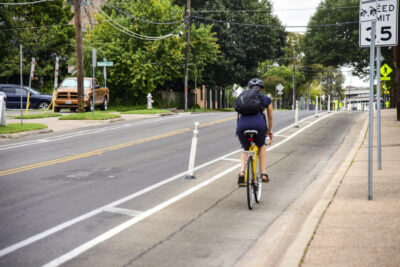
A multidisciplinary team led by the Texas A&M Transportation Institute (TTI) has published a new national guide focused on improving the safety of on-street bicycle facilities. National Cooperative Highway Research Program (NCHRP) Research Report 1136: On-Street Bicycle Facility Design Features—A Guide was developed by TTI in collaboration with Toole Design Group, Portland State University and Safe Streets Research & Consulting.
The TTI team was led by Bahar Dadashova, research scientist and assistant program manager of TTI’s Roadway Safety Program. Co-authors from TTI included Karen Dixon, Okan Gurbuz, Richard Dzinyela, Boya Dai and Shawn Turner.
The report addresses a critical gap in current roadway safety practices: how to design safer bikeways at midblock locations. According to a 2019 report by the National Transportation Safety Board, 59 percent of fatal bicycle crashes occur at midblock locations — far more than at intersections, which often receive the most attention and funding.
“We hope this work supports transportation agencies in their efforts to build safer networks for people biking,” Dadashova said. “Understanding midblock crash patterns and incorporating Safe System principles into everyday design decisions can help save lives.”
The guide synthesizes crash data from across six U.S. cities and one county, pairs it with visual assessments of high-crash sites, and outlines key contextual design factors — like driveway placement and curbside access — that influence bicyclist safety but often fall outside traditional design manuals. The project also developed new crash modification factors for bikeways, helping agencies better quantify safety benefits across different facility types.
The report was recently featured in an NCHRP Impacts on Practice news article, which underscores both the study’s findings and the increased national interest in separated bicycle facilities.
NCHRP Research Report 1136: On-Street Bicycle Facility Design Features—A Guide and its companion Web-Only Document 414: Safety Evaluation of On-Street Bicycle Facility Design Features are available through the National Academies Press.